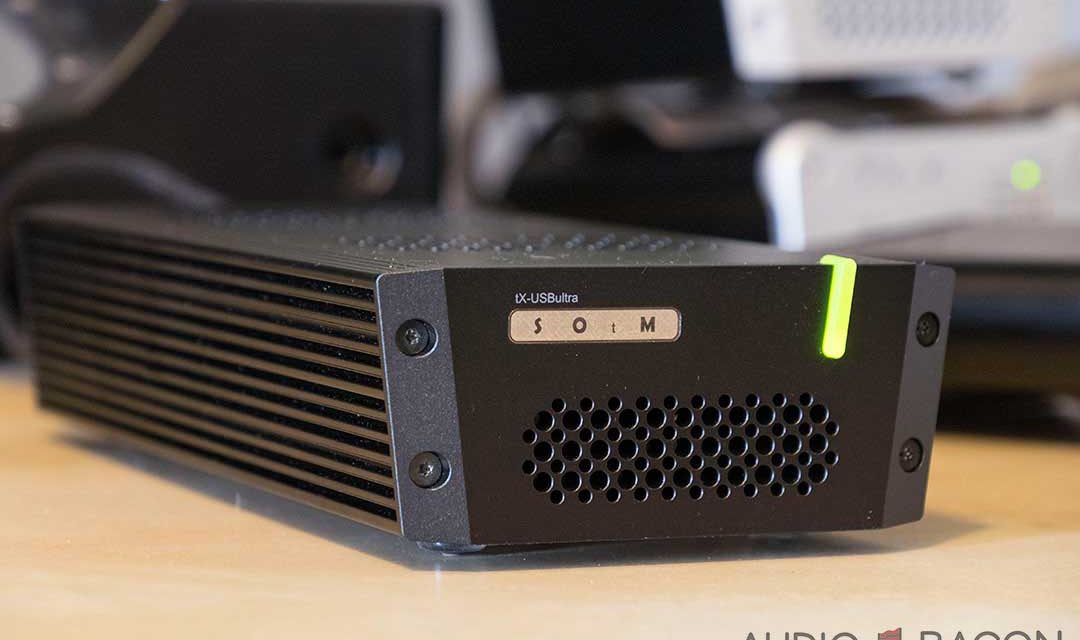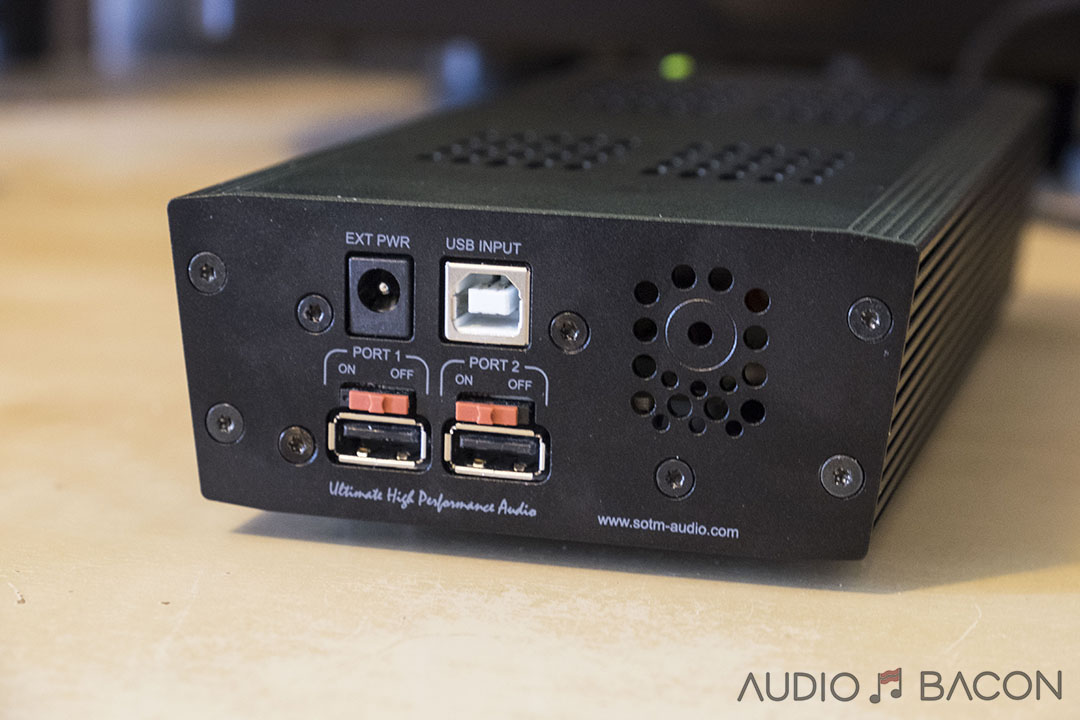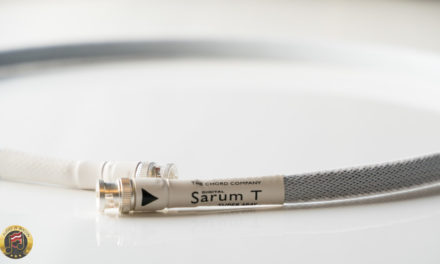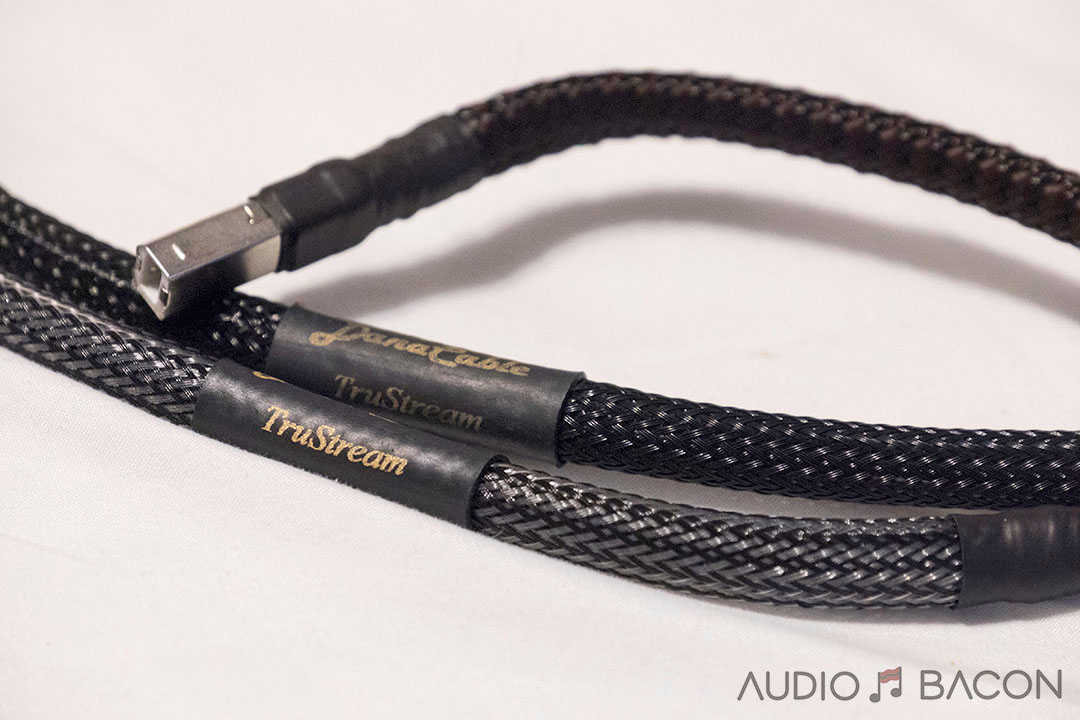Sound Quality
After going through my notes, my top descriptors were “fluid”, “control,” and “lifelike.” I wanted to determine what the tX-USBultra actually does to the music so I did a lot of cable swapping/testing between direct connection to the Chord DAVE and to the tX-USBultra. The bottomline is, the tX takes the incoming signal, reconstructs it perfectly, and send it out in its purest form. That’s it. With other conditioners, there’s a coloring to the sound but with the tX-USBultra, it’s ruthlessly transparent and honest. Swapping input USB cables made me realize it does an enormous amount of bit reconstruction before it outputs the result. Truly remarkable.
In comparison to the W4S Recovery (also powered by the LPS-1), it doesn’t even sound like they’re trying to accomplish the same thing. It’s apparent that the tX-USBultra is something entirely different. It’ll completely correct the phase timing in all your recordings which manifests itself as utter realism in your music.
One track that made me forget about my credit card debt was the live recording of Diablo Ojo off Rodrigo y Gabriela’s new remastered self-titled album.The first minute of this recording is brutal and beautiful at the same time. It sounds exquisite without the tX in the chain and I didn’t feel like I was missing anything. Once the tX was in place…it made me think that the artists themselves don’t even know how good they sound. The amount of tactility presented while still maintaining proper composure in transients and detail is outright astounding. The tX was able to pull out all the nuances of the track and place them on the stage in a very natural (and startling) way. The tX opens up the sound from being dynamically constricted to something so lifelike and limitless, it’s difficult to come up with superlatives to describe. It provides enough body and focus to visualize the performers and instruments along with their realistic size and mass. Same goes for Eric Clapton’s My Father’s Eyes [Take 2]. These live recordings are so clean and analog sounding, I constantly found myself in disbelief during this review.
On the negative side, there’s still a bit of a heightened treble for some recordings which as I’ve mentioned, is probably due to the power cable used for the UpTone LPS-1.
The tX also images everything with the utmost perfection, filters out all the artifacts that I didn’t realize existed, and provides you with subliminal naturalness. What I’ve learned on this audio journey is that you know you’ve found something exceptional when it terrifies you. When it goes beyond goosebumps but makes you think “How is this possible?” I really wish I were exaggerating. There’s little to no hints of digital with the tX-USBultra.
For the live recording of Frank Sinatra’s track Come Fly With Me, the tX not only brought him back from the dead but also rebuilt the Sands Hotel & Casino. When you’re listening to the tX, you’re not thinking about pinpoint imaging, speed, or even the sonic individualism of the performers, you’re too preoccupied with how real it sounds and enjoy just being enveloped by the musical experience before you.
To stress test the tX a bit more, I opted for Enter Sandman by Metallica. This is where that super clock shines and is fully appreciated. It’s apparent that the tX provides limitless extension on both ends. Guitars and drums have perfect decay and weight. You actually feel the performers with their respective instruments. Everything is cohesive while without the tX the sound is more piecewise and contrived. Interestingly enough, I never thought about soundstage because everything just sounded accurately and realistically sized and spaced at all times.
I’m not a huge classical music listener but I thoroughly enjoyed the magic the tX was able to do for this genre. I preferred the Clarity Cable Natural USB cable for this. With the tX, you could hear every intent of the performer. The surreal sense of decay and pause which allows one to hear the moment the performer lets go of the key of a piano or the amount of pressure applied to a violin as the bow graces the strings. Without the tX, everything sounds fat, congested, compressed, and less natural. For example in the Scottish Chamber Orchestra’s Horn Concertino In E minor, Op. 45, the strings, woodwinds, and bass were realistic reproduced in an eerie way. With the incredible resolution, depth, and dynamics, there was a sense of limitless air for the entire recording . Without the tX, it sounded as if the performance were in a small room. The tX actually brought me back to some memories of the Philharmonic at the Hollywood Bowl. A bit freaky I must admit.
In Larry Young’s Zoltan, a direct connection to the sMS-200 lacks the explosive quality of this track. Trumpets and cymbals don’t sound as convincing and don’t have the proper texture and decay. The amount of dynamics and extension the tX-USBultra brings to the table cannot be understated. In short, the music just comes to life and breathes.
The SOtM tX-USBultra is not just a new kid on the box, but something revolutionary. Many, including myself, speak of bringing the live performance into our listening rooms. I now realize I had no clue what I was talking about. When I brought in a few more ears (who were unaware of all the components), every single listener mentioned the word “experience.” Usually I’ll get something along the lines of “I like the bass” or “Sounds good man, how much did you spend again?”
Conclusion
Aside from the monetary barrier of entry, I have no complaints about the SOtM tX-USBultra. Every other USB conditioners have their pros and cons but when you provide the SOtM tX-USBultra with a high quality linear PS and USB cables, it won’t be the bottleneck. In fact, it’ll expose the limitations of your system. In my case, I felt the tX wanted to do more than what the Omega Super 3i speakers could reproduce. It’d be interesting to retest with the Omega Compact Alnico Monitors in a few weeks.
During my reviews, I noticed some recordings had this harshness and distortion I thought was intrinsic to the recording itself. Turns out this insidious noise has been masked by what I perceived to be “normal” because, until now, we didn’t have a good enough device to truly condition the USB signal.
Regardless of the USB cables used, these are the overlaying benefits of the SOtM tX-USBultra:
- Immediate control and tightening of the sound in a very natural way. It does so without losing the “sonic dust” which provides the organics of the music. Without exception, everything sounds more bloated and stretched without the tX in the chain.
- The noise floor is nonexistent. Voices and instruments fade in from black.
- All the artifacts and fuzziness you’ve heard in recordings might not actually be a part of the recording. You don’t hear fuzziness when hear artists sing without a mic. I get a similar impression with the tX.
- Some devices layer and separate well but in a contrived and almost piecewise way. The tX-USBultra pulls apart the music in the most natural way possible.
- Ultimate transparency. A direct connection will always sound a bit more grey with a thin veil.
- A direct connection to the sMS-200, without exception, sounds more confined and dynamically capped. With the tx-USBultra, the music is allowed free-reign over space.
- Brings tactility by unravelling textures hidden in all your recordings.
- More intelligible vocals. You’ll learn more about the tracks you listen to.
- Streamed music from Spotify, Tidal, etc benefit enormously from the tX-USBultra.
I highly value the 3Ts: Timbre, Tone, and Tactility. All three are required for a realistic audio experience. It’s the difference between music that sounds great and music that sounds real. With these USB devices, there are usually tradeoffs. After listening to over 100 tracks with the tX-USBultra, I couldn’t find a single deficiency. It is so effortless in its craft…you would think they incorporated some kind of artificial intelligence. It almost feels like it was taught how a piano, guitar, organ, drum, and human was supposed to sound like and acted accordingly. The SOtM tX-USBultra made the speakers disappear by exhibiting a truly untainted sound with a new level of temporal accuracy. I can’t imagine how it would sound with a better power supply.
People who have gone deep into this hobby know that when you’re startled by a piece of gear, there must be something special there. You find yourself not fast forwarding any tracks or skipping in between. You stop analyzing/critiquing and you just listen. The SOtM tX-USBultra not only raised the bar, it broke it and just rocketed into the stratosphere. The refinement, control, tonal density, and pure visceral experience the tX-USBultra provides is unmatched. It acts as a world class cosmetic surgeon for your ugly streamed music files. It removes all the sonic smearing to provide a fluid, full, and honest presentation. I’m beyond impressed and have not heard anything this emotionally engaging…ever. I have a feeling this is just beginning. Needless to say, the SOtM tX-USBultra USB conditioner makes it into our Finest Cuts.
If you have a USB DAC, give the SOtM tX-USBultra a listen. Just make sure your wallet is open to being violated..because you won’t be returning it. Now if you don’t mind, I’m going to write some poetry.














Hey there,
Definitely an interesting read.
But I wonder if you had the chance to compare it to the Mutec MC-3+ Smart Clock USB, which is in the same price range.
It’s maybe a little bit hard to compare, since it only has one bidirectional USB input/output but offers a lot more flexibility (different inputs/outputs) and is externaly reclocked to rubidium/caesium clocks.
Maybe you can put it on the list of potential alternatives 😉
Cheers
I haven’t had the chance to compare it to the Mutec although if you have one to send in let me know. Rubidium atomic clocks have good long term stability but poor short term (which isn’t the best for audio).
Sorry don’t have one…
and to be honest I don’t fully understand how this remote reclocking works… Hoped you could tell more about how it works.
Just read a few reviews / forum post where people were drooling how this is the reclocker to beat.
Cheers
I’ll have to cover this in-depth with another post but the idea is that the bits are ordered in a timely fashion as they’re streamed from your server. The clocks used on your motherboard, ethernet cards, USB hubs, etc require difference frequencies and have various short and long term performance/stability characteristics. Bits will be disoriented along the path and cause sonic degradation. After hearing the tX, I could tell you the noise is quite substantial. It’s best to have all of these devices sync to a reference clock to reduce phase noise along the chain. The more accurate and stable this clock is, the more honest and humanistic your music will sound.
Thanks for explaining this to me in detail 🙂
By external reclocking I meant the way the Mutec works…
Let me quote the spec sheet:
‘Offers unique externally referenced re-clocking, locking to Rubidium-/Cesium atomic clocks or GPS receivers’
Cheers
Hello Jay, Thanks for yet another great review!
I was wondering if you would also be reviewing the new ISO-Regen from Uptone Audio? It would be quite interesting to see how it stacks up and (fingers crosses) if it can match or exceed this unit’s performance.
Thanks again,
Mike
Hey Mike, that would be interesting indeed. I’m curious as well. I’ll try to get a hold of one soon. Will keep you posted.
A wonderful review once a gain, Jay! Your site has become a true audiophile destination. I am always eager to know what’s next from you.
A couple of comments…just like you, balance is everything to me. Without it, it’s hard to move forward because all I can think of is what’s missing or what there is too much of. I, too, am very sensitive to an overly energetic treble (brightness) and I suspect at least one source of your brightness may be your NVMe SSD drive. Such a drive singlehandedly forced me to move away from a certain Mac Mini that had such a drive. Another Mac Mini I have on hand that runs its OS off an SD card, in comparison, sounds much much less fatiguing. SSDs in general emit a brightness that is largely responsible for the glare that I equate with bad digital, and NVMe drives, in my own experience, are the worst of the lot. Look at their current draw and you’ll find that most NVMe drives draw close to 2A at their peak! Compare that against something like a compact flash card which draws in the order of 2500% less current (which results in much less noise kicked back into the ground plane) and you begin to appreciate why there is a greater relative ease and calmness with such drives. Anyway, the point of this is that you can go to great lengths by mixing and matching USB cables to mitigate this annoying treble energy (at the expense of detail resolution) when the better solution all along maybe to address issues within your server.
Another advantage I have found with superior clocking is the removal of glare. Having several of SOtM’s Ultra devices on hand, as I have combined an sMS-200ultra in series with a tX-USBultra and dX-USB HD Ultra, this glare that we are both sensitive to simply lessens and lessens. If every clock in our signal path, from the router to the DAC, were at the level of SOtM’s new super clock, I suspect, we wouldn’t need so many reparative or regenerative devices to follow the server and that more of us would be writing poetry more regularly.
Hi, Jay!
IN MEDIAS RES: does this dethrone iFi USB re-gen thingies, then 😕
The superclock in the tX changes the game. None of the USB regens I’ve heard so far even compare. Obviously, it’s also much pricier than most options (just the clock is $700).
What do you think about curius usb, is it close to that kings? What are pros nad cons.
The Curious USB has the tonality of the Clarity Cable and I have no hesitation recommending it. The kings have better coherence and timbre but you get an enormous amount of fidelity for the money with the Curious. It’s very holographic, detailed, black as night, with plenty of textures and slam. It’s the best sounding cable I’ve heard so far under $700. That said, their “portable” options for Hugo/Mojo are an absolute steal.
Hello Jay, i enjoyed your review a lot. I own a microrendu with lps-1. I am wondering if this product is likely to make a difference in my setup. Thanks.
Anywhere you’re using an ethernet cable for your music, it’ll improve the SQ (presuming you’re just using a generic).
I am using AQ Forest Ethernet cables along with a TP-Link Gigabit Ethernet Media Converter to clean up the signal from my router.
My current setup is based on this:
https://www.audiostream.com/content/electrically-isolate-your-networked-audio
Thanks Anatoly,
Been looking for this article for quite some time! Bookmarked it now 🙂
I already have a sms-200, stream from my NUC Roon server. is it favorable to replace sms-200 with a TX connect to my NUC by USB ?
As I can’t afford sms-200 & TX together, and I also want to make the chain simple while good in SQ.
From my testing and my gut, it wouldn’t be favorable. The tX directly from my BRIX sounded much thicker and loses out on a lot of clarity and dynamics. It sounded restrained. Another friend of mine who has tried this combination with a server better than the BRIX and NUC mentioned something similar. If you want to shave the sMS-200 off from the chain, you might need to build a new server utilizing SOtM’s USB PCIe device: https://www.sotm-audio.com/sotmwp/english/portfolio-item/tx-usbexp/
Thx for the advice.
Seems using TX still need a high quality USB output from PC or streamer in order to win SQ of sms-200.
By the way, the upgrade cost from sms-200 to sms-200 Ultra is so close to the price of an TX, do you think sms-200 + TX, or sms-200 Ultra alone, will gives better SQ ?
HI thanks for the review! I already own the Sms -200 so your review was very useful.
Just wanted to know what you chain at the beginning was up your BRIX server?
Eg my path upto my server (a NUC Roon ROCK) is:
Wall Socket (internet provider) -.> coaxial cable –> Cable Modem (with built in lan switch) –> Generic Cat 7 lan cable –> ethernet to usb 2 adapter –> Nuc 7i3 (bridged) –> SOtm sMS -200 etc …
In the above I upgraded to the generic Cat 7 lan cable from a generic Cat 5 cable and was really impressed with the improvement.
The is the point of my post. I want to know if you should use a better cable from your router/switch to you server IF it is bridged (like your BRIX is) ?
I have a SOtM CAT7 + iSO-CAT6 + black cable from the modem to the router with a SOtM sPS-500 + Y splitter to power both modem and router. The improvements were dramatic. They’re still distinguishable from local files but no more digital edge and harshness. This setup brings in coherence and warmth. I would still use local files for critical listening but streamed music sounds superb with the proper cables and power supply in place.
Thanks Jay, appreciate the reply.
Looks like I’ll have to get a better power supply for my all in one modem/outer as well a better lan cable from my modem/router to my Roon ROCK Nuc music server. Btw, I don’t stream any music, just local files from my Nuc.
Today as way of quick test I plugged the current modem/router wallwart in to a power HIFi strip (that I bought nearly 20 years ago) and indeed got a really good improvement.
Oh btw from my bridged music server (nic i7i3) to my Sotm sMS 200 I recently upgraded to a 2m Ghent Audio ethernet cable (http://www.ghentaudio.com/part/et02.html). Really made a big difference compared to the generic cat lan 7 cable. Total cost including DHL delivery from China to Sweden was $100.
Thank you for great review.
If you have to choose one between PS audio lanrover and Sotm tx-usbultra, what is your choice?
They kinda serve different purposes. LANRover allows you to have your server/PC in a remote location. Can’t do that with the tX-USBultra. PS Audio = smoother and more analog. SOtM = Quieter, more resolution, and air.
Jay, DanaCable gave me a price for a 3 ft TruStream USB Cable. Do you think this is short enough to avoid the capacitance problem?
I can’t really say. I know a 1.5m didn’t work and the two cables I have are about a foot and the other being around 8 inches (I thought they were at least 2 ft but I was mistaken). I would tell Danacable about what you’re trying to do and hopefully, they’ve come up with a solution where they don’t have to shorten the cable so much.
Ok thanks. Waiting to hear from them. So did the 1 foot and 8″ cables work?
I’d look for an alternative to the Dana as well, giving a similar SQ. The PAD 30th Anniversary at $1500 is a bit much, but PAD does have a copper Ultimate USB cable for $900. Any experience or comment about this one?
FYI based on your reviews of the tX and the ISO, I’ve ordered these units and will put together a setup like yours. Thus the questions about the Dana.
Thanks.
Hey Jay,
I’ve been making myself crazy trying to figure out if the tx-USBultra adds anything to a Chord TT2/M-scaler set up. Some people say that it doesn’t make a difference, as the TT2/M-Scaler reclock the signal anyway. Others say, it makes some things too bright. Others say, there should be know difference.
I’m just curious if you have tried the USBultra with the TT2/M-Scaler? I’m using Abyss TCs and Focal Utopias with a Wa33 amp (if that matters).
Thanks!
Hello Jay. A great comprehensive review. I wonder after all these years ( it’s now 2025) you still rate the SOTM. I’m looking at a Gustard DDC U18 and wonder if the SOTM may be a better option between my computer and Accuphase E480 with DAC-60 card. Regards from New Zealand